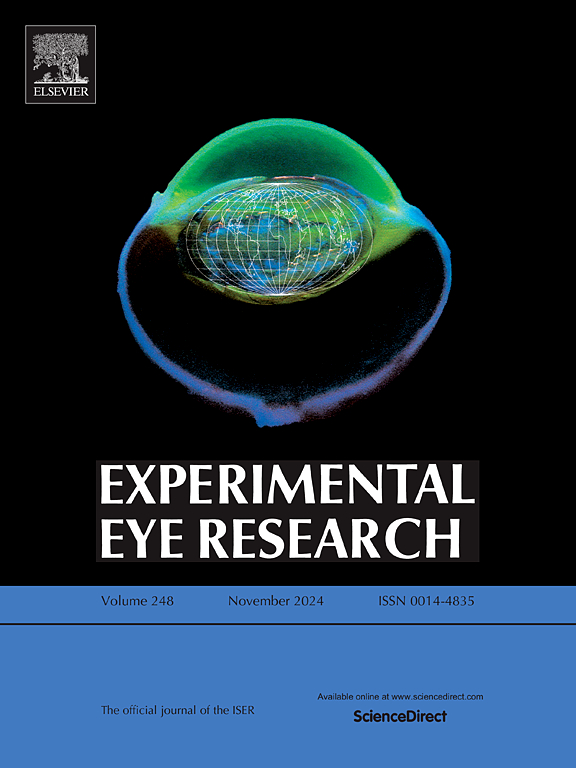TLR4 signal inhibition alleviates alkali-burn induced corneal neovascularization
IF 3
2区 医学
Q1 OPHTHALMOLOGY
引用次数: 0
Abstract
Toll-like receptor 4 (TLR4), recognized as a fundamental mediator of inflammatory signaling, plays a crucial role in orchestrating the inflammatory response. Previous studies suggested that TLR4 knockout (KO) notably reduced corneal vascular areas induced by silver nitrate burn based on the morphological observation. The current study seeks to elucidate the influence of TLR4 signaling on corneal neovascularization (CNV) and to examine the underlying mechanisms. The model of alkali burn (AB)-induced CNV was built using TLR4 KO and wildtype (WT) mice. CNV was detected using a slit lamp. Corneal thickness was evaluated using H&E staining. The expression levels of VEGF-A, MyD88, and NF-κB were evaluated employing Western blot analysis, immunohistochemistry, and Real-time PCR techniques. The inflammation factors, IL-1β, TNF-α, and IL-6, were quantified using Real-time PCR. In addition, Resatorvid (Tak242), a specific inhibitor of TLR4, was used to treat AB cornea of WT mice. AB enhanced TLR4 signaling components, including MyD88 and NF-κB. TLR4 inhibition alleviated AB-induced corneal neovascularization and corneal thickness. The TLR4 signal, inflammatory factors and VEGF-A were also down-regulated. Our data indicated that TLR4 participated in the pathology of AB-induced CNV. TLR4 was over-expressed in the cornea of AB mice. TLR4 inhibition alleviated AB-induced CNV, and suppressed MyD88, NF-κB, VEGF-A, and inflammation factors. These findings may provide new insights for the clinical treatment of AB-induced CNV.
TLR4信号抑制可缓解碱烧伤诱导的角膜新生血管。
toll样受体4 (TLR4)被认为是炎症信号的基本介质,在协调炎症反应中起着至关重要的作用。形态学观察表明,TLR4敲除(KO)可显著减少硝酸银烧伤引起的角膜血管面积。本研究旨在阐明TLR4信号对角膜新生血管(CNV)的影响,并探讨其潜在机制。采用TLR4 KO和野生型(WT)小鼠建立碱烧伤(AB)诱导的CNV模型。用裂隙灯检测CNV。H&E染色评估角膜厚度。采用Western blot分析、免疫组织化学和Real-time PCR技术检测VEGF-A、MyD88和NF-κB的表达水平。采用Real-time PCR定量检测炎症因子IL-1β、TNF-α、IL-6。此外,TLR4特异性抑制剂Resatorvid (Tak242)用于治疗WT小鼠AB型角膜。AB增强了TLR4信号成分,包括MyD88和NF-κB。TLR4抑制可减轻ab诱导的角膜新生血管和角膜厚度。TLR4信号、炎症因子、VEGF-A均下调。我们的数据表明,TLR4参与了ab诱导的CNV的病理过程。TLR4在AB小鼠角膜中过表达。TLR4抑制可减轻ab诱导的CNV,抑制MyD88、NF-κB、VEGF-A和炎症因子。这些发现可能为抗体诱导的CNV的临床治疗提供新的见解。
本文章由计算机程序翻译,如有差异,请以英文原文为准。
求助全文
约1分钟内获得全文
求助全文
来源期刊

Experimental eye research
医学-眼科学
CiteScore
6.80
自引率
5.90%
发文量
323
审稿时长
66 days
期刊介绍:
The primary goal of Experimental Eye Research is to publish original research papers on all aspects of experimental biology of the eye and ocular tissues that seek to define the mechanisms of normal function and/or disease. Studies of ocular tissues that encompass the disciplines of cell biology, developmental biology, genetics, molecular biology, physiology, biochemistry, biophysics, immunology or microbiology are most welcomed. Manuscripts that are purely clinical or in a surgical area of ophthalmology are not appropriate for submission to Experimental Eye Research and if received will be returned without review.
 求助内容:
求助内容: 应助结果提醒方式:
应助结果提醒方式:


